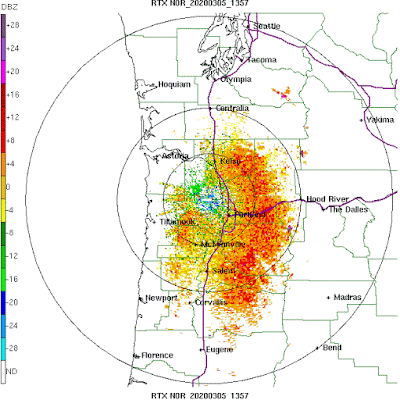Weather Radar Shows Spring Bird Migration
Every day I have been checking the weather radar for signs of the northward migration of our feathered friends, and Wednesday night I finally saw it.
Ornithologists and those tracking the seasonal migration of birds have used weather radar for decades. The radar signal of a target goes up rapidly with the size of the object (with the sixth power of the diameter) and thus a bird provides an immensely bigger signal than a raindrop.
Many birds like to migrate at night, so a good sign of birds is a large area of radar return that starts around sunset and fades at sunrise. Meteorological signals don't do that.
And the birds prefer to stay over land--precipitation does not care much about the shoreline.
So let me show you the birds... first at Portland.
At 5:40 PM Wednesday, right before sunset, nothing much was apparent.
By 6:41 PM, within an hour of sunset, echoes were appearing (reddish color), particularly NE of the city.
Right before sunrise 5:57 AM, the echoes were declining
And gone by 6:59 AM Thursday morning, after sunrise.
National Weather Service radars have Doppler capabilities, which means they can determine the speed of the target towards or away from the radar. Let's check out the velocities of the birdies (see below). Blue/green means approaching and red/orange means moving away.
The radar targets are moving to the north---exactly what we would expect for birds migrating northward.
The Hoquiam (Langley Hill) radar showed the birds as well-- here are the radar returns (called reflectivity) at 9:32 PM Wednesday night. The light blue are birds. They are not going very far offshore.
So why did the birds decide on Wednesday night to begin moving northward. Yes, it was the right time of the year...but there is something else. The meteorology was nearly perfect.
A warm front had moved through the region, followed by strong winds from the south, providing an easy ride! Plus, the front had virtually no rain.
To show you this bird conveyor belt, here are the winds above SeaTac Airport for the 24 hours ending 10 AM Thursday. Time increases to the left and the Y-axis is height in pressure (700-hPa-- is around 10,000 ft). Right after 7 PM Wednesday (05/03), the winds turned strongly southerly (from the south) and stated that way. Literally, a strong tailwind!
These are meteorologically very smart birds.
Ornithologists and those tracking the seasonal migration of birds have used weather radar for decades. The radar signal of a target goes up rapidly with the size of the object (with the sixth power of the diameter) and thus a bird provides an immensely bigger signal than a raindrop.
Many birds like to migrate at night, so a good sign of birds is a large area of radar return that starts around sunset and fades at sunrise. Meteorological signals don't do that.
And the birds prefer to stay over land--precipitation does not care much about the shoreline.
So let me show you the birds... first at Portland.
At 5:40 PM Wednesday, right before sunset, nothing much was apparent.
By 6:41 PM, within an hour of sunset, echoes were appearing (reddish color), particularly NE of the city.
In the middle of the night at 11:49 PM birds were all over the place!
Right before sunrise 5:57 AM, the echoes were declining
And gone by 6:59 AM Thursday morning, after sunrise.
National Weather Service radars have Doppler capabilities, which means they can determine the speed of the target towards or away from the radar. Let's check out the velocities of the birdies (see below). Blue/green means approaching and red/orange means moving away.
The radar targets are moving to the north---exactly what we would expect for birds migrating northward.
The Hoquiam (Langley Hill) radar showed the birds as well-- here are the radar returns (called reflectivity) at 9:32 PM Wednesday night. The light blue are birds. They are not going very far offshore.
So why did the birds decide on Wednesday night to begin moving northward. Yes, it was the right time of the year...but there is something else. The meteorology was nearly perfect.
A warm front had moved through the region, followed by strong winds from the south, providing an easy ride! Plus, the front had virtually no rain.
To show you this bird conveyor belt, here are the winds above SeaTac Airport for the 24 hours ending 10 AM Thursday. Time increases to the left and the Y-axis is height in pressure (700-hPa-- is around 10,000 ft). Right after 7 PM Wednesday (05/03), the winds turned strongly southerly (from the south) and stated that way. Literally, a strong tailwind!
These are meteorologically very smart birds.













Comments
Post a Comment